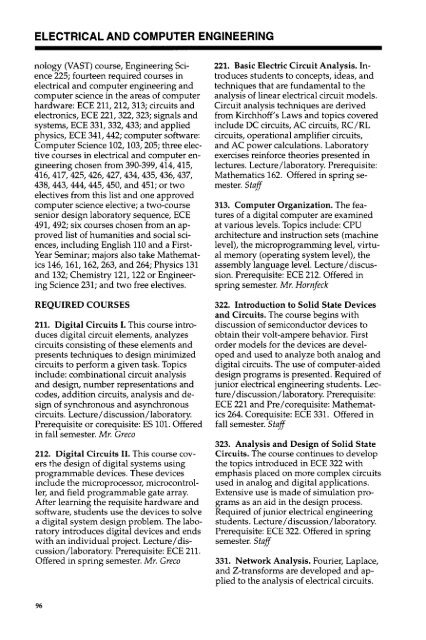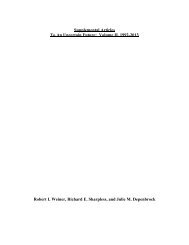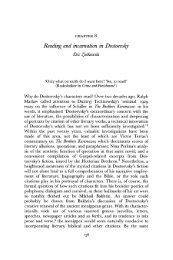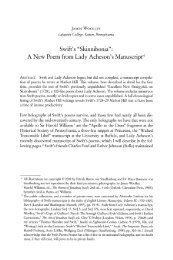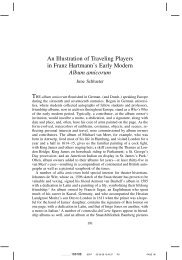courses of instruction - Lafayette College
courses of instruction - Lafayette College
courses of instruction - Lafayette College
You also want an ePaper? Increase the reach of your titles
YUMPU automatically turns print PDFs into web optimized ePapers that Google loves.
ELECTRICAL AND COMPUTER ENGINEERING<br />
nology (VAST) course, Engineering Sci<br />
ence 225; fourteen required <strong>courses</strong> in<br />
electrical and computer engineering and<br />
computer science in the areas <strong>of</strong> computer<br />
hardware: ECE 211, 212, 313; circuits and<br />
electronics, ECE 221, 322, 323; signals and<br />
systems, ECE 331, 332,433; and applied<br />
physics, ECE 341,442; computer s<strong>of</strong>tware:<br />
Computer Science 102,103,205; three elec<br />
tive <strong>courses</strong> in electrical and computer en<br />
gineering chosen from 390-399, 414,415,<br />
416,417, 425,426,427,434,435, 436,437,<br />
438,443, 444,445,450, and 451; or two<br />
electives from this list and one approved<br />
computer science elective; a two-course<br />
senior design laboratory sequence, ECE<br />
491, 492; six <strong>courses</strong> chosen from an ap<br />
proved list <strong>of</strong> humanities and social sci<br />
ences, including English 110 and a First-<br />
Year Seminar; majors also take Mathemat<br />
ics 146,161,162,263, and 264; Physics 131<br />
and 132; Chemistry 121,122 or Engineer<br />
ing Science 231; and two free electives.<br />
REQUIRED COURSES<br />
211. Digital Circuits I. This course intro<br />
duces digital circuit elements, analyzes<br />
circuits consisting <strong>of</strong> these elements and<br />
presents techniques to design minimized<br />
circuits to perform a given task. Topics<br />
include: combinational circuit analysis<br />
and design, number representations and<br />
codes, addition circuits, analysis and de<br />
sign <strong>of</strong> synchronous and asynchronous<br />
circuits. Lecture/discussion/laboratory.<br />
Prerequisite or corequisite: ES 101. Offered<br />
in fall semester. Mr. Greco<br />
212. Digital Circuits II. This course cov<br />
ers the design <strong>of</strong> digital systems using<br />
programmable devices. These devices<br />
include the microprocessor, microcontrol<br />
ler, and field programmable gate array.<br />
After learning the requisite hardware and<br />
s<strong>of</strong>tware, students use the devices to solve<br />
a digital system design problem. The labo<br />
ratory introduces digital devices and ends<br />
with an individual project. Lecture/dis<br />
cussion/laboratory. Prerequisite: ECE 211.<br />
Offered in spring semester. Mr. Greco<br />
96<br />
221. Basic Electric Circuit Analysis. In<br />
troduces students to concepts, ideas, and<br />
techniques that are fundamental to the<br />
analysis <strong>of</strong> linear electrical circuit models.<br />
Circuit analysis techniques are derived<br />
from Kirchh<strong>of</strong>f's Laws and topics covered<br />
include DC circuits, AC circuits, RC/RL<br />
circuits, operational amplifier circuits,<br />
and AC power calculations. Laboratory<br />
exercises reinforce theories presented in<br />
lectures. Lecture/laboratory. Prerequisite:<br />
Mathematics 162. Offered in spring se<br />
mester. Staff<br />
313. Computer Organization. The fea<br />
tures <strong>of</strong> a digital computer are examined<br />
at various levels. Topics include: CPU<br />
architecture and <strong>instruction</strong> sets (machine<br />
level), the microprogramming level, virtu<br />
al memory (operating system level), the<br />
assembly language level. Lecture/discus<br />
sion. Prerequisite: ECE 212. Offered in<br />
spring semester. Mr. Hornfeck<br />
322. Introduction to Solid State Devices<br />
and Circuits. The course begins with<br />
discussion <strong>of</strong> semiconductor devices to<br />
obtain their volt-ampere behavior. First<br />
order models for the devices are devel<br />
oped and used to analyze both analog and<br />
digital circuits. The use <strong>of</strong> computer-aided<br />
design programs is presented. Required <strong>of</strong><br />
junior electrical engineering students. Lec<br />
ture/discussion/laboratory. Prerequisite:<br />
ECE 221 and Pre/corequisite: Mathemat<br />
ics 264. Corequisite: ECE 331. Offered in<br />
fall semester. Staff<br />
323. Analysis and Design <strong>of</strong> Solid State<br />
Circuits. The course continues to develop<br />
the topics introduced in ECE 322 with<br />
emphasis placed on more complex circuits<br />
used in analog and digital applications.<br />
Extensive use is made <strong>of</strong> simulation pro<br />
grams as an aid in the design process.<br />
Required <strong>of</strong> junior electrical engineering<br />
students. Lecture/discussion/ laboratory.<br />
Prerequisite: ECE 322. Offered in spring<br />
semester. Staff<br />
331. Network Analysis. Fourier, Laplace,<br />
and Z-transforms are developed and ap<br />
plied to the analysis <strong>of</strong> electrical circuits.


